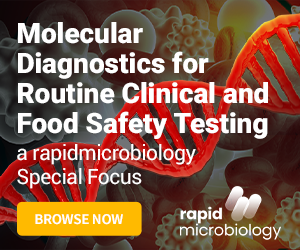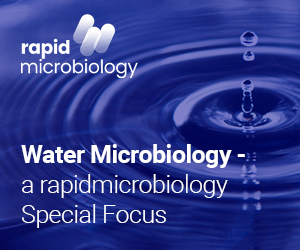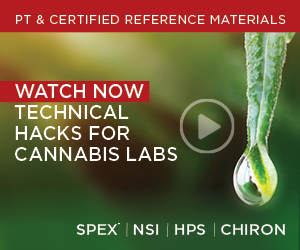Detection of Bacterial Toxins in Food
Key characterisitics
- Traditional methods can be time consuming and difficult to perform.
- Rapid ELISA- and RPLA-based methods are faster and simple to use.
- Lateral flow immunoassays show potential for detecting botulinum toxins
 The term ‘food poisoning’ covers a wide range of food-borne diseases caused by an equally wide range of microorganisms. Most cases of food poisoning are infections caused by bacteria such as Salmonella and Campylobacter, or by viruses.
The term ‘food poisoning’ covers a wide range of food-borne diseases caused by an equally wide range of microorganisms. Most cases of food poisoning are infections caused by bacteria such as Salmonella and Campylobacter, or by viruses.
Less common, but equally important from a food safety point of view, is food poisoning as a result of intoxication. Intoxication occurs as a result of ingesting pre-formed bacterial toxins in food. Live bacterial cells need not be present for food illness to develop. There is also a third type, intermediate food poisoning, which is caused by toxins produced during bacterial growth in the gut.
Only three bacterial species are considered important causes of the intoxication type of food poisoning. These are Bacillus cereus, Clostridium botulinum and Staphylococcus aureus, all of which are capable of causing illness by producing toxins in food. There are several other species of Bacillus and Clostridium that have been reported to produce pre-formed toxins in food, such as B. licheniformis and Cl. butyricum, but these are uncommon and not considered further here.
Detection
There may be occasions when food microbiology laboratories need to test food samples for the presence of bacterial toxins, for example in the investigation of cases of food poisoning, or if a process failure has occurred. This is unlikely to be a routine requirement for most industrial laboratories. However, food research and public health laboratories may find rapid screening tests for suspect food samples useful, especially in the investigation of food poisoning outbreaks where bacterial toxin production is suspected.
Storage and preparation of samples
Foods samples should be collected as for any other microbiological examination and stored under refrigeration for the shortest time practical.
Most of the rapid tests currently available require some sort of extraction and purification procedure before they can detect toxins in food matrices. Some of the components in the food can interfere with the test itself and with the visual interpretation of the test results. It is usually necessary to remove as much of the fat and solid material as possible. Techniques used include centrifugation, filtration through absorbent cotton wool, microfiltration, dialysis, chromatographic separation and the use of immunoaffinity columns.
Bacillus cereus
Bacillus cereus is a Gram-positive spore-forming bacterium, which can produce two different types of toxin. The commonest is the ‘emetic’ or vomiting toxin, a peptide also referred to as cereulide. As the name suggests, the emetic toxin causes rapid onset (0.5 - 6 hours) nausea and vomiting, sometimes accompanied by abdominal cramps and diarrhoea. Symptoms do not usually last for more than 24 hours and complications are rare. Foods involved in B. cereus emetic food poisoning cases are usually starchy, such as boiled or fried rice, potatoes, pasta and noodles. The toxin is extremely heat-stable and will withstand cooking.
The second type of B. cereus toxin is an enterotoxin causing a diarrhoeal type of food poisoning. At least two different enterotoxins have been identified, a haemolysin and a non-haemolytic enterotoxin. An intermediate type of food poisoning can occur when enterotoxin is released in the gut, but toxin can also be pre-formed in foods. Symptoms include watery diarrhoea, abdominal pain and occasional vomiting, but recovery typically takes place within 24 hours. Foods associated with this form of food poisoning are varied, but include meat and vegetable dishes, soups and sauces. B. cereus enterotoxins are acid-labile and easily destroyed by heating.
Traditional detection and identification methods
The diarrhoeal enterotoxin of B. cereus was only characterised comparatively recently and methods for its detection in foods have not been in use for very long. The FDA Bacteriological Analytical Manual (BAM) includes a serology-based microslide gel double diffusion method for detection of the toxin, but this is intended for use with culture filtrates rather than food samples.
Available detection methods for the emetic toxin are limited to bioassays and chemical techniques, such as HPLC-MS.
Rapid methods
Rapid methods for B. cereus enterotoxin have been developed based on the ELISA technique. These methods are quite sensitive and usually require only a simple extraction step.
Reversed passive latex agglutination (RPLA) methods have also been developed commercially for use with food and culture filtrates. An example is the Oxoid BCET-RPLA Toxin Detection Kit. This too requires only a simple extraction procedure before use and provides a result in 24 hours.
Lateral flow test systems uses monoclonal, rather than polyclonal antibodies for improved specificity and is said to be suitable for the rapid (time to result 4.5 hours) screening of food samples as well as for confirmation of B. cereus in culture.
Clostridium botulinum
The Gram-positive anaerobic bacterial species Clostridium botulinum is the causative organism for the very severe illness, botulism. Botulism is caused by highly potent neurotoxins, some of the most powerful known natural toxins, which can be pre-formed in food during growth of Cl. botulinum cells. There are at least seven different types of Cl. botulinum (A – G), each forming a different toxin. These can be divided into four groups, but only two, Groups I and II, are important in food safety.
Group I
Group I strains of Cl. botulinum are referred to as ‘proteolytic’ and may produce toxin types A, B or F. They are widely distributed in nature, being found in a variety of raw foods, and produce highly heat-resistant endospores.
Botulinum toxin can cause symptoms at very low concentrations (possibly as low as 0.005 μg). The onset of symptoms typically takes 12-36 hours, but depends on the amount of toxin ingested and can take much longer. Symptoms include initial diarrhoea and vomiting followed by neurological effects including blurred vision, weakness, and difficulty swallowing, talking and breathing. If not diagnosed early, mortality rates can be as high as 40%, but modern treatments have reduced this to less than 10%. Foods involved in outbreaks are usually under-preserved meat or fish products, but a range of other foods may be implicated, including vegetables preserved in oil and cheeses. The toxins are not heat-stable and can be inactivated during cooking.
Group II
Group II strains are referred to as ‘non-proteolytic’ and produce toxin types B, E or F. They are able to grow at temperatures as low as 3oC. They are widespread in nature, but type E strains are especially common in the marine environment. There has been much concern that these bacteria may produce toxin in refrigerated processed foods without apparent spoilage. The spores of Group II Cl. botulinum are much less heat-resistant than those of Group I strains.
Group II toxins are thought to be slightly less potent than Group I types, requiring at least 0.1 μg to cause symptoms. But in other respects they differ very little. Foods involved in outbreaks of Group II botulism include cold-smoked fish and other preserved fish products.
Traditional detection and identification methods
Traditional detection and identification methods for botulinum toxins in food samples typically involve time consuming and expensive bioassays. These methods are only suitable for a very few designated laboratories equipped to carry out bioassays using mice under strict containment conditions. The mouse bioassay takes at least six days to complete.
Rapid methods
ELISA-based methods have been developed for examining food samples for botulinum toxins. For example, the BAM includes a method using digoxigen labelled IgGs and ELISA (DIG-ELISA), which can be used to test food samples and/or cultures for toxin. Able to detect toxins at concentrations as low as 0.12-0.25 ng/ml, the method is said to be more sensitive than the mouse bioassay and produces results within 24 hours, although some food matrices may interfere with the test.
Recently, concern about the possibility of terrorist attack with botulinum toxins has prompted the development of some commercial test kits, especially in the USA. Most of these are lateral flow immunoassay devices designed principally for bio-defence applications. Published studies suggest that some of these products could be used for rapid screening of food samples, but that they are only sensitive enough to be used as presumptive tests.
Safety note: Any laboratory considering working with Clostridium botulinum and its toxins must have suitable high-level containment facilities and trained staff. It is unlikely that any industrial laboratory performing routine microbiological analysis will be able to meet the safety standards required.
Staphylococcus aureus
Staphylococcus spp. are Gram-positive, non-sporeforming cocci. The most important toxigenic species in food microbiology is Staph. aureus, although other species, such as Staph. intermedius may also produce toxins. At least 14 different staphylococcal enterotoxins have been described (designated A-O, with several gaps in the sequence). The commonest toxin type in food poisoning is type A, but types C, B, D and E have also been implicated.
Staphylococcal enterotoxins are heat-stable proteins and pre-formed in foods. Ingestion of food containing at least 0.1-1 μg of toxin can cause a mild form of food poisoning with a rapid onset of symptoms (2-4 hours), including nausea and vomiting with abdominal cramps, occasionally followed by diarrhoea. Recovery is usually completed within 48 hours and deaths are very rare.
Foods associated with staphylococcal food poisoning include dairy-based products, such as cream and custard, cured and cooked meats and cheeses. Outbreaks have also been linked to pasta, sandwiches and sausages. High-risk foods are those that are handled extensively and undergo cooking or curing. Staphylococcal enterotoxins are heat resistant and will withstand cooking.
Traditional detection and identification methods
The detection and identification of staphylococcal enterotoxins in food has been carried out routinely in some laboratories for many years. The methods of choice are serological and a microslide gel double diffusion test has been widely used. An example of this method for food samples and culture filtrates is described in the BAM. Unfortunately these methods are not very sensitive and usually require a lengthy concentration stage to detect the low levels of enterotoxin that are capable of causing illness. They can also be difficult to interpret.
Rapid methods
Rapid methods for testing food samples for staphylococcal enterotoxins are much more widely available and better established than those for B. cereus toxins and botulinum toxins.
The majority of commercially available methods use ELISA technology and are able to produce a result in a few hours. Commercial kits may be in microplate or tube format and sometimes include immunoaffinity columns (IAC) for concentration of toxins from foods. ELISA kits for identification of specific staphylococcal enterotoxins are also available from some suppliers.
Automated test based on Enzyme-Linked Fluorescence Assays (EFLA) are available. Other commercially available test kits include an RPLA-based test from Oxoid, the SET-RPLA toxin detection kit.
Get the latest updates in Rapid Microbiological Test Methods sent to your email?
Subscribe to the free rapidmicrobiology eNewsletter







